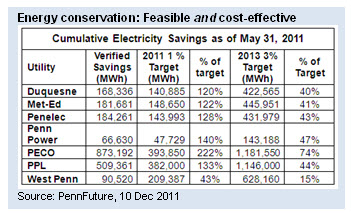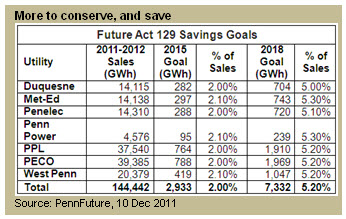And it is NOT a well.
This is a sample article from the February 2012 issue of EEnergy Informer.
In October 2008, state of Pennsylvania passed a law, Act 129, with the intention of curtailing energy demand, reducing pollution and creating jobs. Pennsylvania, which has become the center of shale gas boom in the last few years, is not generally regarded as overly green, clean or environmentally conscious. Which makes this story particularly noteworthy.
From the start, Act 129 — which required utilities to reduce their electricity sales by a relatively modest 1% by May 2011, 3% by May 2013 and reduce peak demand by 4.5% over the same period — had its share of skeptics who said it couldn’t be done, it would be too costly, or both.

PennFuture, in its 10 Dec 2011 issue, reports that through May 2011 — the first milestone — the measure has reduced Pennsylvania’s electric consumption by 2,073 GWhrs, an impressive 41% greater than was required under the mandate. All Pennsylvania utilities except one exceeded the required target (see Table above). Moreover, the results were achieved while saving $278 million per annum from customer bills who participated in the scheme. That much for the skeptics.
According to an analysis done by Optimal Energy, a consulting firm, over the expected life of the installed energy efficiency measures, the savings would amount to $2.3 billion in present value terms from an upfront investment of $281 million.

Consumers, on the average would gain $8 for every dollar spent under the program, an impressive return by any metrics imaginable. Alternatively, the negawatts were obtained at a levelized cost of 1.6 cents/kWh compared to a levelized cost of around 10 cents/kWh for megawatts from conventional coal-fired generation, the main source of electricity generation in Pennsylvania.
That is not all. Optimal claims that the Act has resulted in 4,000 additional jobs or 15 per every $1 million spent on energy efficiency, and has reduced greenhouse gas emissions by the equivalent of taking 4 million cars off the road – Pennsylvania’s generation mix not being particularly green. As a point of reference, Pennsylvania’s emissions are roughly 1% of global emissions, according to the National Environmental Trust, or roughly half of California, a much more populous state.
Not surprisingly, the environmental community is prodding the state’s lawmakers and regulators to extend the Act, which is set to expire in May 2013. PennFuture says the current goal of 1% savings per annum is feasible and cost-effective. Optimal Energy estimates that extending the Act to 2018 would result in cumulative reduction of 7,330 GWh and $932 million in annual electric bill savings to customers.
Over the expected life of the installed energy efficiency measures, these savings represent a present value of $7.8 billion, an avoidance of 80 million tons of carbon dioxide emissions, the equivalent of taking 14 million cars off the road, and the creation of over 14,000 job-years. Energy efficiency, as Amory Lovins is fond of saying, is not just a free lunch, it is a lunch we’re paid to eat.
The experience of Pennsylvania, as impressive as it is for a state not generally regarded as a front-runner in energy efficiency, is not unique. Similar mandatory goals in other states, including Texas, have also produced impressive results that did not seem achievable or cost-effective. One can generally assume that 1%, and higher, reductions in annual electricity consumption are doable and cost-effective. Why they are not being tried — and mandated — more broadly and more aggressively is the real puzzle.

